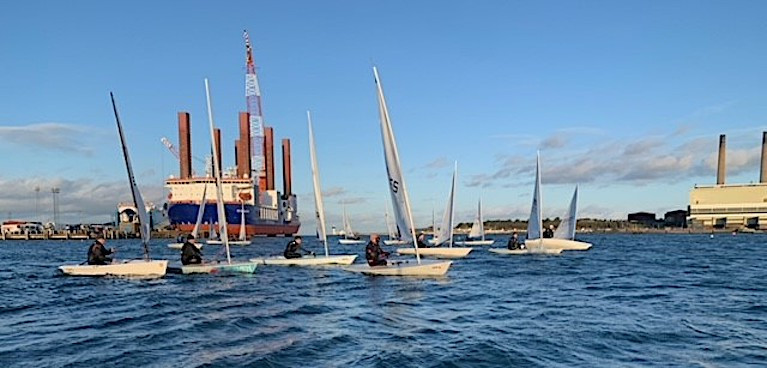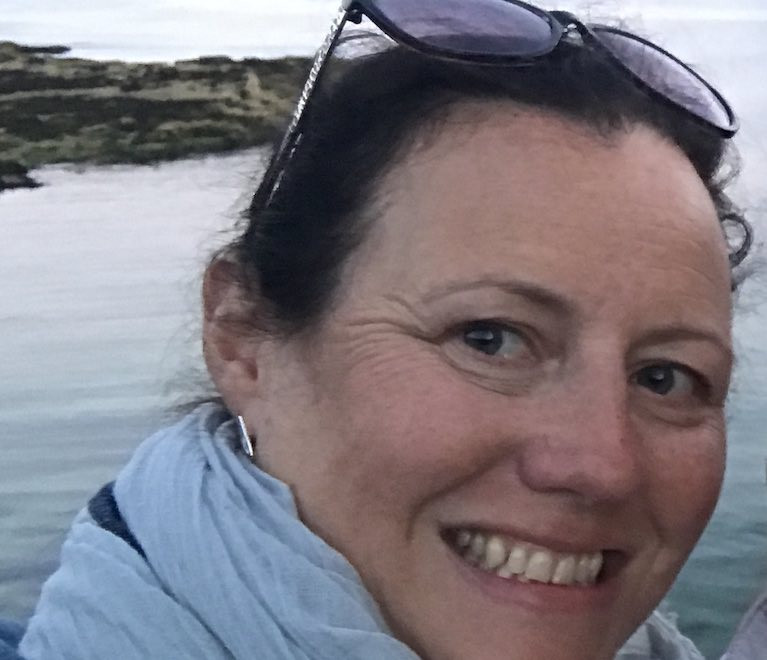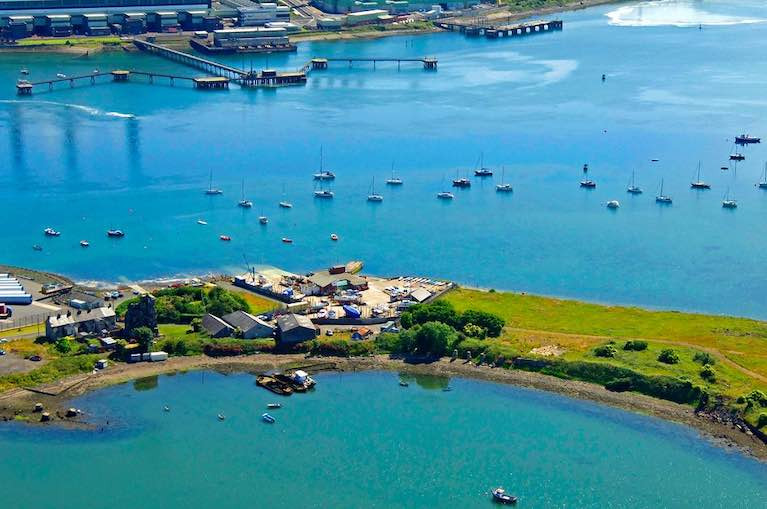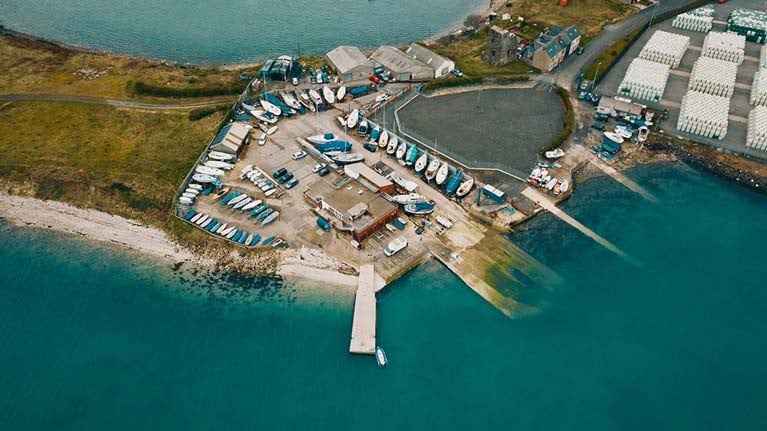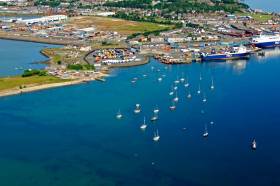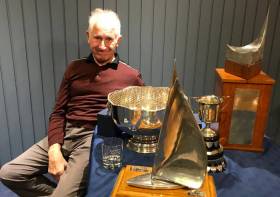Displaying items by tag: EAST ANTRIM BOAT CLUB
Carrickfergus Sailing Club's J80 Jezebel Takes First Gun at East Antrim Boat Club Regatta
Despite a smaller than usual turnout at Larne last weekend for the East Antrim Boat Club Regatta, racing was keen, and on Saturday, the fleet enjoyed perfect conditions, with the breeze picking up for the second race on the Sunday.
Racing run by Race Officer Richard Doig was held outside Larne Lough on the east Antrim coast, where the club is based, between Town Parks and Drains Bay, about 6km north of the Lough entrance.
 East Antrim BC Regatta weekend - Mayor Cllr William McCaughey Mid & East Antrim Council, Luch Whitford (front) and the crew of Sirius
East Antrim BC Regatta weekend - Mayor Cllr William McCaughey Mid & East Antrim Council, Luch Whitford (front) and the crew of Sirius
Visitors from Carrickfergus SC on in Belfast Lough topped the overall results both days with Alan McClernon's J80 Jezebel first overall on Saturday with the Flying Fifteen of Bryan Willis second. On a Sunday, it was Brian and Ryan Wilson's Corby 29 Elixir first, with the host club's Richard Doig's GK24 Sirius helmed by Ryan Brown, runner up.
 Brian and Ryan Wilson's Corby 29 Elixir
Brian and Ryan Wilson's Corby 29 Elixir
Local business Allan Dorman and Son sponsored the weekend.
It was back to dinghy racing at the Larne club, East Antrim, for the May Day regatta on Sunday 2nd under current NI Covid restrictions.
There was a good turnout of 21 in four classes – Optimist, Toppers, Single and Double Handers.
The Doig family dominated the Oppies and Toppers, with four members in the Optimist and Toppers. Freddie was the first Optimist with three bullets, and Fraser won the Toppers coincidentally with the same score. Tom Coulter took first in a Laser Radial with another Doig, Gavin, runner up in the ten single Handers. Zoe Whitford and Kelly Patterson in a 29er won the Double Hander fleet, which included three Flying Fifteens.
 Tom Coulter racing in the Laser Radial at EABC Photo: Sue Kitson
Tom Coulter racing in the Laser Radial at EABC Photo: Sue Kitson
Sunday racing continues through until September.
Single-Handers Race for Christmas Regatta Honours at East Antrim Boat Club
Seventeen single-handers took advantage of a favourable day on Sunday last (20th) to hold a Christmas Regatta at East Antrim Boat Club on Larne Lough before the shut down in Northern Ireland on Boxing Day.
The fleet consisted of two Optimists and a Topper racing together, nine Laser Radials, four Laser 4.7s and an Aero starting as a group.
The fleet raced in Larne Harbour, currently the base for MPI Resolution, the world's first purpose-built vessel for installing offshore wind turbines that is pictured top and as Afloat reported previously here.
 Gavin (left) and George Doig at East Antrim Boat Club Photo: Sue Kitson
Gavin (left) and George Doig at East Antrim Boat Club Photo: Sue Kitson
The Doig family dominated the results with three generations out on the water. Freddie Doig finished first overall in his Optimist with his younger brother George second, and Dad Gavin was the first Radial with up-and-coming sailor 15-year-old Tom Coulter runner up. First Laser 4.7 was Zoe Whitford – she and Tom both won prizes at the Youth Championships in September. To complete the Doig trio, Grandad Peter raced the Aero.
Commodore Lucy Whitford was pleased with the event. "We had a great day today, cold but good sailing. Unfortunately, due to restrictions we are sailing single-handers".
 Mixed single-handed dinghies racing at the EABC Christmas Regatta on Larne Lough
Mixed single-handed dinghies racing at the EABC Christmas Regatta on Larne Lough
East Antrim Boat Club Appoints Lucy Whitford as Commodore
East Antrim Boat Club in Larne has appointed Lucy Whitford as Commodore, only the third lady in the Club's 70-year history to enjoy that position.
The others were Lilian Stewart and Anne Morris.
Although Lucy is a regular sailor, and her daughter Zoe is a leading Topper helm as well as a 29er sailor and is currently on the RYANI's Youth Performance Programme, Lucy comes from a motorsport background. She competed in motorsport from the age of 16, first auto testing and then rallying, surely a lot faster than anything she would be used to now. It was a family thing as both her parents competed, and her husband is also involved.
Although Lucy appreciates the responsibility which is now hers, she says " Being a woman in the role wasn't actually something that was in my mind at all. I suppose both in my sailing and motorsport I never wanted to be singled out as a girl - I just wanted to compete. I feel the same about this position and for me it is about everyone working together to continue to retain the values we have at EABC as we are a relatively small family orientated club. I sailed a lot with my Dad, Mike Ford-Hutchinson but after he died suddenly in 1999, I moved away from sailing and back to motorsport where I started rallying. I didn't sail for about 10 years, but I was keen for my daughter to learn and that really brought me back to the Club. It's been great to get back to club sailing and take our daughter to sailing events across Ireland and farther afield which has allowed me to re-connect with old friends and meet new ones!"
Topper Event at East Antrim Boat Club Cancelled By New Northern Ireland COVID Restrictions
As a result of the new NI Executive Covid restrictions announced on 14th October, East Antrim Boat Club at Larne has cancelled the Topper Northern championship event scheduled for 24th and 25th October.
The EABC Covid team said, "The organising committee felt that it could not run the event in good faith with the latest restrictions in place".
The Halloween Regatta is still due to take place on the 1st November and this event, as well as the Winter Series and Christmas Regatta, will be open to visitors.
More details, including the format and how to enter, will be made available in the coming days.
Club dinghy racing will continue as normal this Sunday (18th) with the first gun at 1:30 pm and the Sunday morning training will continue in single-handed boats and with household crews (where social distancing is possible).
GP14 'Hot Toddy' Event Cancelled at East Antrim
An important GP14 event, the Hot Toddy, first saw the light of day in the early eighties when the then GP14 Association of Ireland charged their East Antrim Boat Club based fleet with the creation of a new and suitable end-of-season 'fun' event.
And it was due to be celebrated again this year at the Larne club but as has happened to so many events due to the ongoing Covid-19 pandemic, the organising committee has decided to cancel it. Scheduled to take place on 10th and 11th of October the Club had hoped to welcome at least some well-known GP14 stalwarts – the host club's Curly Morris and Robert Gingles and Ger Owens and Melanie Morris, daughter of Curly, as well as regulars on the GP circuit, John and Donal McGuiness, Hugh Gill, Colman Grimes, Katie Dwyer and Michelle Rowley, and Bill and James Johnson.
The decision was not taken lightly as everyone involved was keen for the event to go ahead. Unfortunately, with the current restrictions in place across the island, particularly in Dublin, it was deemed inappropriate to run the event at present.
However, the silver lining for the members is that the slipway will be available as normal this weekend and Club racing will take place on Sunday, 11th October. The Topper Northerns on 24th and 25th October is currently scheduled to go ahead.
Members of the Larne club will welcome its General Committee’s decision to make the most of the lockdown easing, for hot on the heels of RYA NI advice that Step 2 of the Northern Ireland Executive’s Pathway to Recovery has now been reached, dinghy racing will re-start. Although indoor restrictions remain in place, groups of up to 10 people are now allowed to meet outdoors.
The RYA Volvo champion club was established in 1950 on Larne Lough and has been associated principally with the GP14 class. Among the well-known sailors in that class were Johnny McWilliam, Curly Morris, Paul Rowan, Tom Jobling and the Fekkes brothers. Mirrors and Optimists were popular with the young sailors and now the up and coming helms sail Lasers and Toppers. There is a cruiser-racer fleet as well, moored in the shelter lough just off the club.
The plan is to begin a new series on the first Sunday in July. Today (21st June) and the following Sunday (28th June) will be used as trial races to work through any issues that may arise.
Guidelines will include the size of groups starting at different times, ie juniors and adults, and double and single handers, with each start limited to no more than 10 competitors.
If more than 10 people wish to take part, priority will be given to those who have been involved in the most Sunday races in the last 12 months. Changing rooms will remain closed and competitors will arrive in their sailing gear or get changed in the yard if they are comfortable doing so.
The slipway will be split in two to allow for the use of both the dinghy and keelboat slipways simultaneously and there will be committee boat starts with safety boats manned by members of the same household where possible.
Racing will not take place if the Race Officer deems the conditions to be Inappropriate and competitors are urged to be more thorough in pre-race checks of their equipment to reduce the risk of failure.
The Committee stresses that Covid-19 is still a very real threat and says “We are far from returning to normal. We are fortunate in that dinghy racing is an outdoor activity that is socially distant by nature. We would ask that all members respect the measures in place which will hopefully mean that we can continue with an official series in July. The onus is on each of us as individuals to ensure that this is possible”. The Procedures and Risk Assessment are here
East Antrim Boat Club Seeks Final Votes for UK Club of Year Award
As the final days of voting for the UK's Sailing Club of the Year draw near, and as Northern Ireland's East Antrim Boat Club is for sure the minnow in the competition the Larne club is looking for every single vote available to bring this award across the Irish sea for the first time.
As Afloat previously reported, the Royal Yachting Association and Yacht&Yachting magazine's annual UK-wide 'Club of the Year' competition is now well underway with the final 10 finalist's destiny – as in 'Strictly' – resting with the public vote!
EABC has made it into that elite top ten. They have already scooped one of the special category awards having been recognised for its particular achievement in 'embracing modern communication'.
It was a jubilant Steven Kirby – immediate past Commodore – who broke the news to an expectant EABC membership just before Christmas. He said: "Not only is it a tremendous feat to have made it into the finals but we've picked up one of the special category awards as well." He continued, "Moreover we are out to win, and bring this prestigious award across the Irish Sea for the first time. But to do so, we really need the support of the Larne public, whether that is from nautical types or land-lubbers: sporty or academic folk or weather you hail from the charity or industrial sectors. We need every available vote to pull this off!"
East Antrim Boat Club's new Commodore Richard Ford-Hutchinson also said. "Ours is a compact forward-looking vibrant organisation with a diverse membership. However in comparison to some of our cross channel opponents, the big South of England clubs for example; we are 'the minnows'. This is why we have put the call out to the Larne public and to you, the Mid., and East Antrim residents to get behind us. My club is awash with champion sailors and long-distance cruising yachtsmen so winning this UK-wide award would be the icing on the plate." Two former world sailing champions and EABC members Mark Fekkes and Andy Thompson have endorsed Commodore Ford-Hutchinson's call.
The voting for the' RYA - Club of the Year' will close on 27th January 2020. Time is slipping away. Here is how to vote, in five easy steps:
- 1. Go to East Antrim Boat Club's website; www.eabc.club.
- 2. On the home page locate the 'white triangular finalist pennant/button'.
- 3. Click it. You will be transferred directly to the vote page of the magazine Yachts &Yachting.
- 4. Follow the links and ...VOTE for EAST ANTRIM BOAT CLUB.
- 5. No computer, smart phone or tablet! Call at the Book Nook or McFarland's Chemists on Larne Main Street; they'll help...
Two NI Clubs Make Final List For RYA/Yachts & Yachting Club Of The Year 2020
Strangford Lough Yacht Club and East Antrim Boat Club in Northern Ireland have been named among the 10 finalists selected for the RYA and Yachts & Yachting Club of the Year Award for 2020.
East Antrim Boat Club is also among five of the finalists recognised for particular achievements, with the Larne Lough club acknowledged for ‘Embracing Modern Communications’.
The annual RYA and Yachts & Yachting Club of the Year Award, supported by Gallagher, recognises the outstanding achievement of sailing clubs across the UK and promotes the hard work and dedication that goes into running a successful club.
Voting opens on Friday 13 December, and the award presentations and overall winner announcement will be made at the RYA Dinghy Show 2020 on Saturday 29 February.
A septuagenarian yachtsman has scooped the top award at the recent East Antrim Boat Club prize-giving event, writes Tom Jobling.
Maurice Adams, who has Parkinson’s, received the solid silver trophy — presented to EABC by the Gingles family in the mid 1970s — at the gala awards evening at the Larne Lough club over the Halloween weekend.
What makes Maurice’s achievement memorable is that Larne has no marina pontoon facilities so, just as his competitors do, he must get out to his craft, a Nova 27, via an inflatable dinghy, and scramble aboard.
Owner Eddie Cameron remarked: “Even with his dual walking aids, Maurice is not the most mobile man ashore these days, but each evening, regardless of the conditions, and as we draw alongside Sahure, he’’s up over the guard-wire and into her cockpit like a ship’s cat up a pole.
"Then with tiller clutched, he becomes ‘made-over’ … back into yacht-racing mode.”
As well as winning the top award, the Sahure crew, with Maurice driving, also won their class within the club’s points racing season.
But Maurice is no stranger to success. Formerly a member of the now-defunct Larne Rowing & Sailing Club, he has raced various sailboats over his long career afloat on Northern Ireland waters: Flying 15s, Highland 18s and number of cruisers.
“Maurice Adams,” Commodore Steven Kirby remarked, as he held ready the trophy, “is not famed for his time-keeping these days — well, other than on the starting line.”
Totally unaware of his award, Mr Adams arrived at the Boat Club as the final prizes were being handed out. His trophy, however, was already in the safe hands of his ever-caring crew.




























